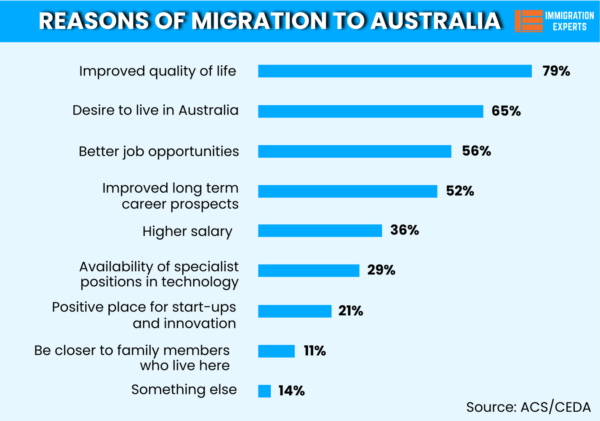051 8439995, 042 35911332

New research from ACS reveals that eight out of ten skilled Information and Communication Technology (ICT) migrants in Australia discover “fulfilling roles” within the country’s IT sector. However, the study also highlights challenges faced by over half of these migrants, including complex migration processes, workplace discrimination, visa-related issues, and a scarcity of IT job opportunities in regional areas.
The initial installment in a series of analyses monitoring ICT migration outcomes, titled “Skilled Journeys: Navigating IT Migration in Australia,” examined 2,303 ICT skilled migrants in mid-2023. The findings revealed that 90% of these skilled migrants successfully secured some form of employment in Australia, with 80% specifically employed in the IT sector.
Satisfaction among Australia’s Migrant Tech Professionals
The majority of respondents expressed satisfaction with their choice to migrate to Australia, indicating a willingness to recommend the move to others. This positive sentiment suggests that international campaigns promoting Australia as a favorable migration destination are likely to resonate well with potential migrants.

The report’s findings challenge the prevailing narrative that gig economy work is an inevitable consequence of Australia’s skilled migration system, according to Siobhan O’Sullivan, ACS chief growth officer, as the report was unveiled.
Regarding the IT workforce, she emphasized, “The vast majority are discovering fulfilling roles in the appropriate fields.” She highlighted that skilled migrants are making a valuable contribution, assisting in addressing the critical shortage of IT professionals in Australia. This contribution is especially significant at a time when the tech industry is experiencing an unprecedented demand for skilled talent.
Skilled Migration’s Impact on Regional Australia: Challenges and Recommendations
Skilled migration has notably benefited regional areas, with 27% of respondents indicating they reside outside of major cities like Sydney, Melbourne, and Brisbane—showing an increase from 18% in 2017. However, this growth is threatened by job availability concerns. Only 43% of respondents expressed intentions to stay in regional areas for more than five years or indefinitely.
To address this issue, the ACS recommends providing additional incentives for migrants and employers in regional areas. They also advocate for promoting infrastructure development and professional opportunities in these regions.

Siobhan O’Sullivan remarked, “For many migrants, regional Australia lacks the career progression opportunities they seek. This is something we need to address at the policy level.”
Challenges Slowing down the Industry’s Progress
Despite the positive stories shared by respondents, a variety of ongoing issues were highlighted. These included a quarter feeling discriminated against based on their migration status, half expressing that visa restrictions hampered their job search, and a significant portion taking over six months to secure an IT job or resorting to working in different industries. Worryingly, the situation has worsened over time, as 15 percent of respondents reported working outside of IT in 2022, compared to 5 percent in 2018.
The current level of underemployment poses a challenge, especially considering that 56 percent of respondents migrated to Australia for enhanced job opportunities, 52 percent for improved long-term career prospects, and 29 percent for specialized technology roles. Despite 56 percent of ICT skilled migrants holding bachelor’s degrees and 46 percent having postgraduate qualifications—surpassing the education level of Australia’s overall population— the ACS proposes the implementation of focused employment placement initiatives and incentives to encourage employers to engage recent migrants.
Reasons for Migration to Australia

Addressing Australia’s Tech Workforce Challenges
Without addressing these issues, attracting top talent in technology and other sectors may become increasingly difficult, according to Melinda Cilento, Chief Executive of the Committee for Economic Development of Australia (CEDA). Previous CEDA research estimates that underutilizing skilled migrants’ capabilities resulted in a staggering $1.25 billion in foregone wages for Australia between 2013 and 2018 alone.
Despite the urgency to increase Australia’s tech workforce from 935,000 to 1.2 million by 2030, as advocated by various entities including the ACS, gender imbalance and a shortage of skilled workers persist in many organizations, hindering efforts to fill lucrative tech positions. There is a growing consensus for proactive measures to revamp VET training, university education, and skills development strategies, and introduce innovative training methods, alongside reforms in the Australian Public Service in terms of engagement, to enhance the skills pipeline.

Australia Simplifying Migration for Skilled Workers
The federal government, amidst recent controversies over migration changes affecting overseas university students, is urged by the ACS to address systemic barriers. This includes focusing on simplifying pathways to permanent residency and citizenship to provide clearer migration outcomes, thus facilitating smoother integration of skilled migrants into the workforce. The government’s Skilled Migration plan, incorporating streamlined visa pathways like the Skills in Demand visa and simplifying overall immigration processes, is hailed as a beneficial initiative by Geoff Purcell, Chief Digital Officer at James Cook University. Purcell emphasizes that these reforms extend beyond mere job filling; they are designed to stimulate innovation, bolster regional development, and ensure the migration system remains adaptable to the dynamic requirements of the economy. The initiative is perceived as a strategic move to address critical skills shortages and enhance global competitiveness.
